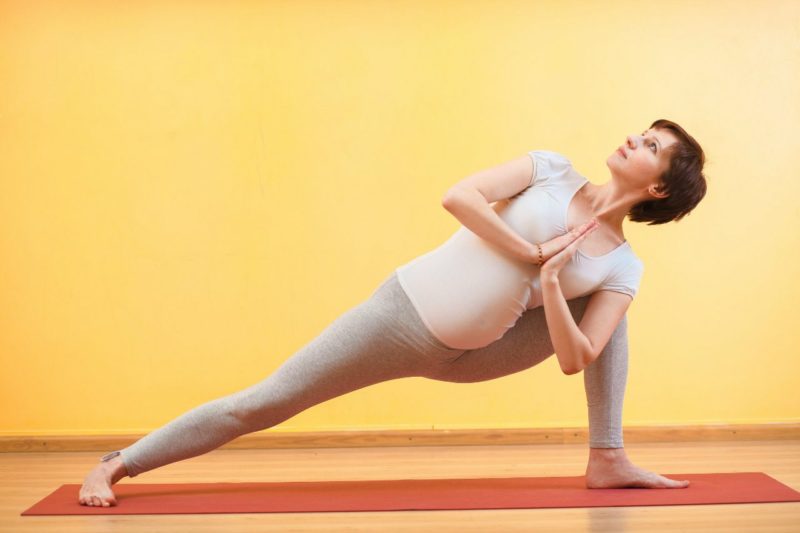During pregnancy, the woman’s body undergoes cardinal changes that can cause significant discomfort to the expectant mother. Needless to say, what a heavy load is placed on the spine and joints by the long-awaited baby developing in the womb? In this case, yoga for pregnant women allows you to get rid of painful enslavements and swelling, and also prepares the female body for subsequent childbirth.
Material Content:
Is it possible to do yoga during pregnancy?
As a rule, issues related to physical activity often concern women who first find themselves in such an interesting position. Fear of harming a small baby makes many mothers refuse during this period from intense physical exertion. And although yoga involves doing the exercises at a calm pace, many are intimidated by the complexity of some intricate elements.
Despite this, many doctors unanimously claim that moderate exercise is essential during pregnancy. Yoga, in turn, not only prepares the body for future births, but also helps to restore its former physical shape as soon as possible after the birth of the child. In addition, systematic exercises with a competent specialist develop breathing, relax muscles and eliminate unpleasant pain in the spine.
Note! A set of exercises is selected taking into account the individual characteristics of a particular organism. Before starting classes, it is important to consult with your healthcare provider first.
The benefits of classes for the expectant mother
Just note that yoga classes for pregnant women are significantly different from the usual workouts, involving a full load. For future mothers, the training process is carried out using special equipment that facilitates the performance of complex asanas. A correctly composed set of exercises is aimed more at working out breathing and relaxing the body, rather than at increasing the stamina of the whole organism.
Moderate loads allow you to achieve the following results:
- reduction of pain in the joints and spine;
- elimination of headaches and insomnia;
- normalization of blood sugar;
- removal of puffiness;
- metabolic processes are activated.
In addition, classes improve the overall well-being of a woman, relieve bouts of depression, and also help control negative emotions. After all, we all know that against the background of hormonal changes, sharp mood swings occur.
The main benefit of yoga for pregnant women is to restore inner peace of mind and learn how to cope with their own emotions.
Basic rules and principles
In order for your body to benefit from training, it is important that you follow the basic safety rules:
- Beginners who have never done yoga in their lives need to start acquaintance with simpler and slower asanas.
- During the exercise, there should not be any unpleasant or painful sensations. In case of pain or nausea, you should carefully exit the situation. Remember - no sudden movements!
- For each trimester of pregnancy, a certain complex of asanas is selected. Even in the early stages, you should avoid exercises while lying on your stomach, as well as all kinds of deflections.
- Classes should be performed on a regular basis. At the same time, do not overdo it and excessively act on weakened ligaments. Asanas should eliminate the load on the muscles of the abdominal cavity.
- Observe changes in your body before and after your workout. It is very important not to allow excessive fatigue. Yoga during pregnancy should have a positive effect on your physical and emotional state.
Tips & Limitations
As already noted above, the used asanas should not involve the abdominal muscles. Any manipulations with the abdominal wall, whether it be a vacuum or nauli, can lead to the most irreversible consequences, up to a miscarriage in the early stages or premature birth in the last trimester. Deep bends in the lower back and strong twisting are also prohibited. Such loads provoke subluxation of the vertebrae, and this, in turn, threatens subsequent serious back injuries.
It is best to give preference to simple exercises that do not require deflection of the spine. Fortunately, in yoga there are enough effective and safe asanas, such as tadasana, “butterfly” or “half-bridge”, which provide an effective effect on all muscle groups. Experts recommend doing the workout in the morning immediately after awakening the body.
It is necessary to start exercises on an empty stomach so as not to provoke an unpleasant feeling of nausea.
Pay special attention to postures that help your pelvic and perineal muscles work out. It is these exercises that make soft tissues more elastic, preventing painful tears during childbirth.
Types of Yoga for Pregnant Women
At the initial stage, pregnant women, especially those who have just started to learn the basics, are recommended to perform exercises under the supervision of a competent specialist.
Among the most suitable varieties of yoga, the following methods are distinguished:
- Iyengar Yoga. The most suitable option for beginners. During the class, asanas are performed with the use of additional devices that help ease the load. Fitballs, pillows, elastic bands, chairs and other items are used as inventory.
- Aqua yoga.A completely new, but rapidly developing area. Training in water is highly effective, strengthens the spine and helps to lose extra pounds. Experts say that water procedures have a positive effect both on the body of a pregnant woman and on the development of the unborn baby.
- Perinatal Yoga A direction designed specifically for women in an interesting position. This type of yoga will be an excellent load at all stages of pregnancy, as well as during the planning of the child. The set of exercises includes slow flowing asanas. In this case, special attention is paid to proper breathing throughout the workout.
In the later stages of pregnancy, intensive hatha yoga should be abandoned.
This practice involves performing static exercises aimed at increasing endurance. To expectant mothers, such excessive loads will only do harm.
Recommended Asanas
Pregnancy is not a disease, which means you are not required to limit your physical activity. Yoga classes in this case will be an excellent alternative for both beginners and all mothers who, before pregnancy, had an active lifestyle.
Experts advise giving preference to the following asanas:
- Viparita Karani Mudra. The pose resembles a birch familiar to everyone, but the pelvis is not raised very high. During the execution, the pelvis is held by the palms, and the elbows rest on the floor. At the initial stage, no more than 2 minutes remain in this position. Over time, the duration is gradually increased.
- Konasana or asana butterfly. While in a sitting position, the legs are bent at the knees and spread them apart. The feet are tightly pressed against each other. In this position, it is important to keep the spine level. We try to relax the hip joints and bring the knees as close to the floor as possible.
- Malasana. The feet are set shoulder width apart. Then slowly lower the pelvis as low as possible. Toes and knees look to the side. We try not to tear off the heels from the floor, and we press our palms to each other. Do not bend in the lower back, and do not lower the shoulder blades. These asanas can be practiced at home, following a step-by-step technique.
Exercises in the 1st, 2nd and 3rd trimesters
Even if you have been practicing various yoga practices for more than a year, in the early stages of pregnancy you should limit yourself to performing the simplest asanas. It is very important not to allow severe overwork or sudden jerks.
In the 1st trimester, give preference to the following exercises:
- Cat pose Get on your knees, resting your palms on the floor. In the position on all fours, slowly bend in the back, first one way, then the other.
- Tree pose. Stand upright, lift one leg and place your foot on the inside of the thigh of the supporting leg. The knee should look to the side. Raise your hands above your head and connect your palms. In this position should be at least 2 minutes.
Starting from 4 months of pregnancy, the body gradually adapts to a new state, a woman ceases to torment an unpleasant feeling of nausea. Yoga in the 2nd trimester may include more complex asanas. However, excessive load on the abdominal wall area should be avoided.
- Virasana. Sit on your knees, rear feet apart slightly wider. Next, try to seat the pelvis on the floor, avoiding bending in the back.
- Half bridge. Lie on your back, place your feet on the floor, bending your knees. Then slowly raise your pelvis up. Hands remain lying along the torso. Hold in this position for 15 seconds, and then slowly lower the pelvis back.
- Lotus position Sitting position, in which the legs are bent at the knees and cross between each other. This asana helps to open the hip joints, and also restores mental balance.
In the later stages of pregnancy, you must be extremely careful. The simpler the asanas performed, the better.Listen to your body, do not over-strain or pain.
In the 3rd trimester, limit yourself to the following poses:
- Tadasana. Stand straight, distribute the weight evenly on the fore and hind legs. Keep your back steady and slowly inhale and then exhale.
- Pose of a bent candle. On the 3rd trimester, asanas are performed using auxiliary devices. An ordinary pillow is placed under the lower back and slowly lift straight legs at a right angle.
It is also recommended to perform various simple exercises that work out the hip joints and the back of the thigh. To do this, sit on the mat, legs spread slightly wider than the shoulders, after which the body is tilted first to the left, then to the right.
Contraindications
Before you start practicing yoga during pregnancy, you should familiarize yourself with all the contraindications available to this.
These include:
- placenta previa;
- uterine hypertonicity;
- high blood pressure;
- preeclampsia;
- severe toxicosis;
- polyhydramnios.
The long-awaited news about pregnancy becomes the event that divides your whole life into “before” and “after”. Now you are responsible not only for yourself, but also for the future baby. Be prudent, consult your doctor and inform him of even the most minor changes in your body.


















